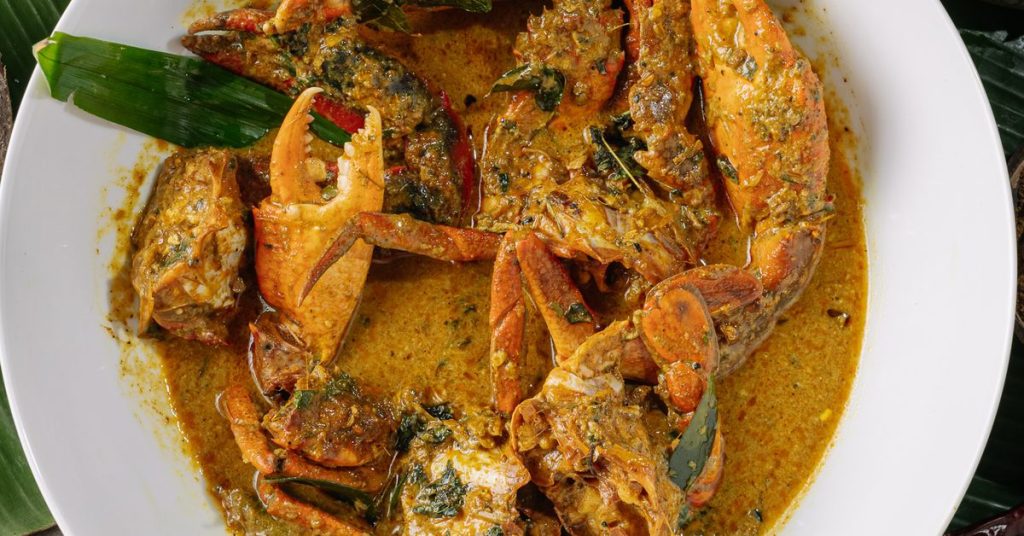Floating just below the southern tip of India, Sri Lanka is a stunningly verdant island cloaked in jungles. Roads lace their way around rice paddies, curry leaf plants and pandan groves sprout in backyards, 800 miles of shoreline teem with crabs and prawns, and coconuts are ubiquitous.
Over the centuries, locals have come up with plenty of ways to make these resources into delicious meals. Grandmas in floral cheeththa dresses deep-fry kokis (flower-shaped coconut rice snacks); cafes pour cups of frothy, milky tea; families set up outdoor fires to slow-cook baby jackfruit in coconut milk; and tappers climb kithul (fishtail palm) trees to collect sap for treacle and jaggery. More recently, as chefs have been working up seasonal menus to highlight local specialties and homegrown bars have been remixing native spirits, Sri Lanka drew millions of tourists in 2024, announcing the island’s comeback on the global stage after a few years of economic uncertainty.
Many visitors get stuck on the tourist track, where bland smoothie bowls and watered-down curries are the norm. But it’s easy to find great meals if you know where to eat. Although often used as just a pitstop, the capital Colombo is home to a host of impressive restaurants and bars, as well as legendary bakeries, diners, and weekend markets. The southern coast is dotted with restaurants offering bounties from the sea. And to the north, chefs draw on the cuisine of nearby Tamil Nadu in southern India. Travel around and you’ll be rewarded.
What’s the food in Sri Lanka like?
To say Sri Lanka has one cuisine ignores its deep culinary influences and strengths. From the second century BCE to the 15th century, the island was a strategic stop in the Maritime Silk Route for Arab, Persian, and Indian merchants. Then Europeans arrived, starting with the Portuguese in the 16th century, followed by the Dutch in the 17th, and in the late 18th, the British, who held onto the island for almost 150 years.
Local cooking still carries the impressions of these colonial and regional powers. Ingredients like masoor dal (split red lentils, imported from nearby India) are everyday essentials. Portuguese baking traditions linger, like the use of pumpkin preserves in festive cakes. Indian and West Asian snacks like samosas and drinks like falooda are popular. And dodol, a sticky, dark brown sweetmeat, appears at celebratory meals, as it does in former European colonies nearby like India, Malaysia, and the Philippines.
In the early 19th century, the British introduced tea to the island’s rainy highlands, leading Sri Lanka to become the world’s third-largest exporter of tea. Many locals begin their days with a cup thickened with fresh or powdered milk. The British also brought down South Indian laborers to work the plantations, and their descendants now form the Malaiyaha Tamil community in tea towns like Nuwara Eliya, where there’s a strong South Indian influence at vegetarian-only restaurants. Sri Lankan Tamils also call the northern side of Sri Lanka home; as you move north, coconuts give way to palmyra palms in the dry, arid plains and you’ll find lots of restaurants cooking crabs, prawns, and cuttlefish with roasted spices.
:no_upscale()/cdn.vox-cdn.com/uploads/chorus_asset/file/25861097/Orange_husked_king_coconuts_on_the_streets_of_Colombo.jpg)
:no_upscale()/cdn.vox-cdn.com/uploads/chorus_asset/file/25861094/Wade__deep_fried__donut_shaped_urad_dal_patties_sold_on_a_moving_train.jpg)
:no_upscale()/cdn.vox-cdn.com/uploads/chorus_asset/file/25862179/fox_jaffna_1.jpg)
:no_upscale()/cdn.vox-cdn.com/uploads/chorus_asset/file/25861233/shutterstock_1228065334.jpg)
Key terms for food lovers
Bath: Directly translated, bath just means cooked rice, but it often refers to a complex mix of rice and vegetables, protein (egg, fish, chicken, pork), dal, popadam, pol sambola (chile coconut relish), and maybe mallung (sauteed greens and coconut). Some ingredients may be assembled into a coconut curry. Or vendors might package them into tight parcels for lunch on the go.
Shorties: Deep-fried, breaded pancakes stuffed with spicy fish and potato (fish rolls), triangle-shaped rotis stuffed with curried vegetables (elawalu roti), steamed rice dumplings filled with moong dal and jaggery (modakam) — these are only a few snacks lumped under the umbrella of “shorties” (short for “short eats”). Generally eaten with tea or soft drinks, short eats are available in bakeries, locals’ joints, and sit-down restaurants.
Kotthu: To prepare kotthu, cooks use metal clamps to rhythmically mix shredded godamba roti (flaky flatbread), vegetables, eggs, and meat (mostly chicken or beef) on a heated iron grill. The dish is arguably Sri Lanka’s heart and soul, and the sound of the metal blades creates a signature tak-a-tak that fills the streets. Kotthu is greasy, messy, cheap, filling, and generally regarded as a hangover cure. Some varieties include curd and milk (palandi kotthu), cheese, or fiery spices (masala kotthu).
Raa, Toddy, and Arrack: Raa or toddy is a mildly alcoholic beverage, made from the sap of palm trees, often enjoyed at village taverns. When distilled, it becomes arrack, which has become a common ingredient in modern cocktails.
Hotel: Not only places to bed down, “hotels” can refer to casual eateries for affordable, filling food. Strangers sit elbow to elbow as they cram down snacks or full meals.
Saivar kade: Traditionally associated with vegetarian shops serving Tamil Sri Lankan fare — dosas, idli, frothy milky tea — the term “saivar kade” is now used more generally for small eateries serving affordable food.
Ammachchi: Nearly two decades ago, the Ministry of Agriculture launched a program to encourage women-run restaurants to boost female entrepreneurship. Today, you’ll find women dressed in vibrant green aprons working at vegetarian stalls, called ammachi unavagam (grandma’s kitchen) in the north and hela bojun hala (native food stall) in the rest of the island.
Choon paan: In Sri Lanka, you might hear Beethoven’s “Für Elise” at any moment. Choon paan vendors play the song as they drive around selling freshly baked short eats, typically stacked in glass cabinets tied to small tuk tuks.
:no_upscale()/cdn.vox-cdn.com/uploads/chorus_asset/file/25861209/GettyImages_2171108924.jpg)
Where to eat in and around Colombo
Upali’s by Nawaloka
For decades, Upali’s has cemented itself as Colombo’s welcome committee, introducing diners to all things Sri Lankan cuisine. Once a residential home, the restaurant boasts a terrace overlooking Viharamahadevi Park. Come for breakfast, when you’ll find kiribath (rice cooked in coconut milk) to pair with spicy chicken curry and lunu miris (fiery onion and chile relish). Wash it down with a glass of kola kenda, an herbal smoothie made of rice, coconut, and greens.
VOC Cafe
Descendants of Europeans who intermarried the native Sinhalese and Tamils, Burghers draw on foodways from Europe and former colonies like Malaysia, Indonesia, and Goa, India. Housed in a colonial-era building, the legendary VOC Cafe offers a taste of the cuisine in a lamprais: a parcel of rice, meat curry (usually lamb, pork, and beef), sweet and sour eggplant, belacan (fermented shrimp paste), frikkadels (meatballs), and ash plantain curry, all baked in a banana leaf.
Gini
Gini is perhaps Colombo’s best restaurant right now. In the outdoor kitchen, chefs apply open-fire cooking to simple, everyday Sri Lankan ingredients. The seasonal menus dip into fresh, lagoon-caught oysters with bloody mary flavored-gazpacho and squid grilled with lime aioli and pol sambola (chile coconut relish).
Cyril Rodrigo’s Green Cabin
With a history running back to 1884, this fifth-generation bakery was one of the first establishments to introduce the short eats culture to Colombo. The shorties game is still strong, but you can also drop by for appam (hoppers): bowl-shaped snacks with thin, crispy edges made of fermented rice flour and coconut milk. Get an egg-topped hopper with some lunu miris (onion and chile relish), or go sweet with a version topped with melted hakuru (jaggery).
Perera & Sons
One of the earliest bakers in Sri Lanka, P&S is where locals get their daily short eats: breaded rolls loaded with boiled egg and spiced minced fish, or oven-baked buns packed with a curried paste of fish and potatoes.
The best restaurants in Southern Sri Lanka
Metta’s Homecooking
Aunty Mettha cooks up local-style fried rice, kotthu, and rice and curry. Her restaurant feels like a welcoming home, despite the location in the touristy town of Unawatuna. Don’t miss the ambarella curry, which features sour, unripe june plums.
Duni’s Hoppers
This small vegan cafe in Hiriketiya plates up incredible fusion hoppers for brunch. The beetroot-colored pink hoppers are served with dal, tomato chutney, and gotu kola sambol (pennywort salad), while sweet jaggery hoppers come topped with coconut yogurt, granola, and banana.
Luuma
Located outside Galle’s tourist buzz, Lumma is ideal for lingering over dinner by the beach. In addition to the excellent mahi-mahi cooked in coconut curry sauce with Thai herbs, the menu includes grilled lobsters, lagoon-caught mud crabs, oysters, calamari, and cuttlefish.
Maru
The UNESCO-listed iconic Galle Fort houses a bunch of phenomenal dining spots, but Maru tops the list. The kitchen blends Mexican and Japanese dishes with Sri Lankan influences. Think tuna poke bowls dressed in soy infused with nai miris (fiery, pungent local chile pepper) or nori tacos topped with grilled prawns.
Shanti Shanti
Along the busy thoroughfare that connects Galle and Matara, residents head for Shanti Shanti, a coconut palm-shaded spot on the beach in Talpe with stunning sunset views and beach swings. Fusion pizzas nod to island roots with toppings like prawn and kangkung (water spinach leaves), while mains include grilled calamari and crab curry.
:no_upscale()/cdn.vox-cdn.com/uploads/chorus_asset/file/25862141/shutterstock_1549966844.jpg)
:no_upscale()/cdn.vox-cdn.com/uploads/chorus_asset/file/25862135/3Z2A3295__1_.jpg)
The best meals in Jaffna and Northern Sri Lanka
Peninsula
Set in the Jaffna location of Jetwing hotels, Peninsula hosts buffets most nights, with dishes like crab cooked with roasted curry powder or odiyal kool: a spicy tamarind stew packed with prawns, crabs, and fish. The kitchen also serves South Indian dishes like dosas and pittu (steamed ground rice layered with scraped coconut).
Fox Jaffna
Fox celebrates the fiery flavors of Northern Sri Lankan cuisine. Go for spicy prawn curry with idiyappam (steamed rice noodles pressed into mats) or mutton bone rasam (peppery, tangy goat broth). After dinner, check out the adjoining bunkers, once used during the Sri Lankan civil war and now for impressive galleries.
Tiki
Set in the backyard of the chef’s own home, Tiki serves seafood dinners based on whatever ingredients are available, which could mean pan-fried mullet, prawns, crabs, or spicy mutton curry. It all goes well with idiyappam. The vibe is intimate and the conversation free-flowing.
Lavin’s
Jaffna locals and tourists cross paths at Lavin’s, where South Indian vegetarian fare is served on banana leaves. Come for a crispy dosa, best washed down with a cup of sweet, frothy filter kaapi (South Indian coffee) at breakfast. At lunch, go for parotta (flaky flatbread) with coconut chutney and chickpea curry.
:no_upscale()/cdn.vox-cdn.com/uploads/chorus_asset/file/25861095/toddy_tapping_in_Jaffna.jpg)
The best places to drink in Sri Lanka
Labookellie Tea Lounge
You can try a selection of Sri Lankan teas at the Labookellie Tea Lounge, housed inside the food court at Colombo’s Marino Mall. The lounge also stocks freshly baked pastries, cakes, and short eats, and it’s got some great sea views.
Uncle’s
Colombo gets to sleep early, but not Uncle’s. Located on the trendy Park Street, the bar skillfully combines arrack in concoctions with kitchen ingredients like pandan leaves and crispy, crunchy wade bites (deep-fried, donut-shaped urad dal patties).
Smoke & Bitters
Perhaps Sri Lanka’s best bar — and listed on the Asia’s 50 Best Bars list for three years now — Smoke & Bitters has put the island’s mixology on the global map. Framed by swaying coconut palms, this part tavern, part smokehouse sits by the beach in the surf town Hiriketiya. Drinks focus on native ingredients, like a classic mai tai with rum-infused chai.
Kaiyo
Russian mixologist Alexandra Kharitonkina heads this incredible sushi bar in the beach town of Weligama, where cocktails and mocktails derive inspiration from Sri Lanka’s various regions. Take the whiskey-based Sabaragamuwa, which combines ranawara (an ayurvedic herb) with nutmeg, clove bitters, and bael (an aromatic fruit with yellow, fibrous pulp).
Zephyr Ceylon
Sri Lanka’s south coast is overrun with taverns, but head for this beach bar in Kamburugamuwa for the perfect view of sunset. Order something spicy, like a tequila cocktail blended with capsicum syrup and local chile bitters. Bites like batter-fried prawns are outstanding, too.
The best food markets in Sri Lanka
Saturday Good Market
This weekly market in Colombo’s illustrious Cinnamon Gardens neighborhood mostly caters to small, independent brands selling sustainable crafts, homeware, and jewelry. A handful of stalls also sell some of Colombo’s best bath, achcharu (pickled tropical fruits like mango, Ceylon olive, and pineapple sprinkled with chile), and traditional Tamil breakfasts like kuzhi paniyaram: crispy, ball-shaped dumplings of urad dal and rice.
Jaffna Market
Jaffna’s lively central market is always abuzz with vendors offloading produce from nearby farms. You’ll find aisles and aisles stacked with Karthakolomban (juicy native mango), varieties of bananas, and wine made from local grapes.
Negombo Fish Market
This market in Negombo is gritty and the smells are potent from the salted fish, which lies sun-drying on black plastic sheets on the beach. Early risers will witness a frenzy of activity at around 5 a.m., when fishers are busy sharpening knives and chopping away at huge swordfish, yellowfin tuna, and sharks.
:no_upscale()/cdn.vox-cdn.com/uploads/chorus_asset/file/25861211/Wild_Coast_2.jpg)
:no_upscale()/cdn.vox-cdn.com/uploads/chorus_asset/file/25861212/Wild_Coast_cooking_class.jpg)
The best hotels in Sri Lanka for great food and drink
Srilax
A residential home turned into a charming boutique, Srilax is a far cry from the chain hotels along busy Marine Drive. Downstairs, co-owner Shana and her mother Dinali Dandeniya (central figures in the city’s dining scene) run Kumbuk, a beloved cafe, serving spicy jackfruit burrito bowls and turmeric-battered fish and chips. Rooms start at $45 in the high season.
Wild Coast Tented Lodge
The tents of this lodge blend seamlessly into the rugged scrublands and rocky outcrops in Yala National Park. The in-house restaurant and Ten Tuskers Bar weave around the bamboo-shaded pool, serving lake fish with lotus seed rice, buffalo curd sprinkled with kithul palm treacle, and a series of arrack-based cocktails. All-inclusive rooms start at $1,000 in the high season.
Galle Fort Hotel
Centuries of stories are woven into the walls of Galle Fort Hotel, a 300-year-old Dutch-era mansion that now boasts 11 suites and a photogenic courtyard. The hotel bar specializes in arrack-based drinks, and the food menu includes babath, a tripe dish prepared with coconut and lemongrass rooted in Sri Lanka’s Malay community. Doubles start at $495 in the high season.
Lunuganga
The late Geoffrey Bawa, Sri Lanka’s most celebrated architect, spent about 50 years at his country estate, Lunuganga, on the banks of Dedduwa Lake. Now managed by Teardrop Hotels, Bawa’s home is open for bookings. The restaurant looks over sprawling gardens and the lake below. Doubles start at $205 in the high season.
Anantara Peace Haven
Set in a secluded, coconut-fringed bay of beach town Tangalle, Anantara hosts private experiences, like clay pot cooking classes led by local female chefs on the hotel’s own small farm. The fine dining venue, Il Mare, serves some of the best Italian food in the country. Doubles start at $374 in the high season.








